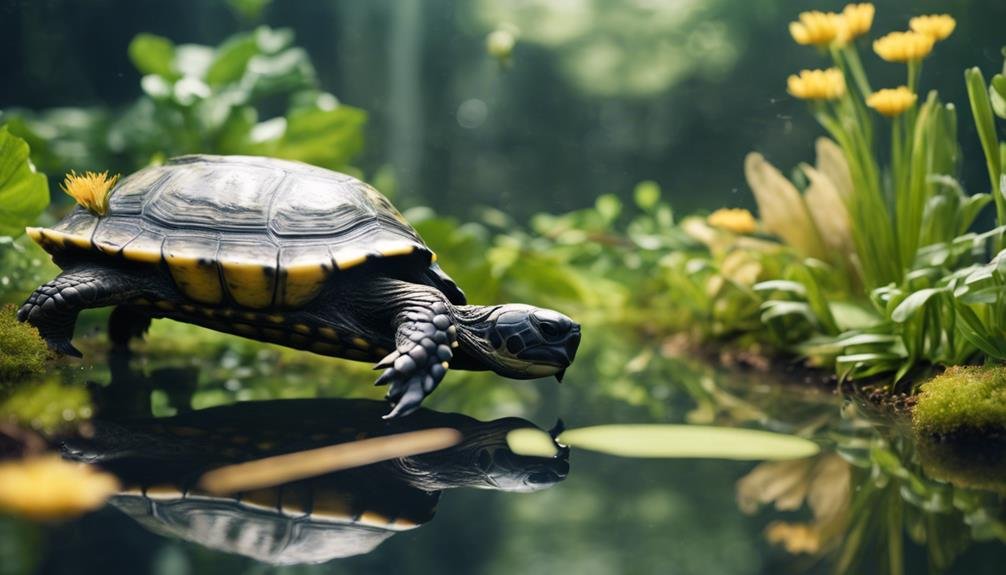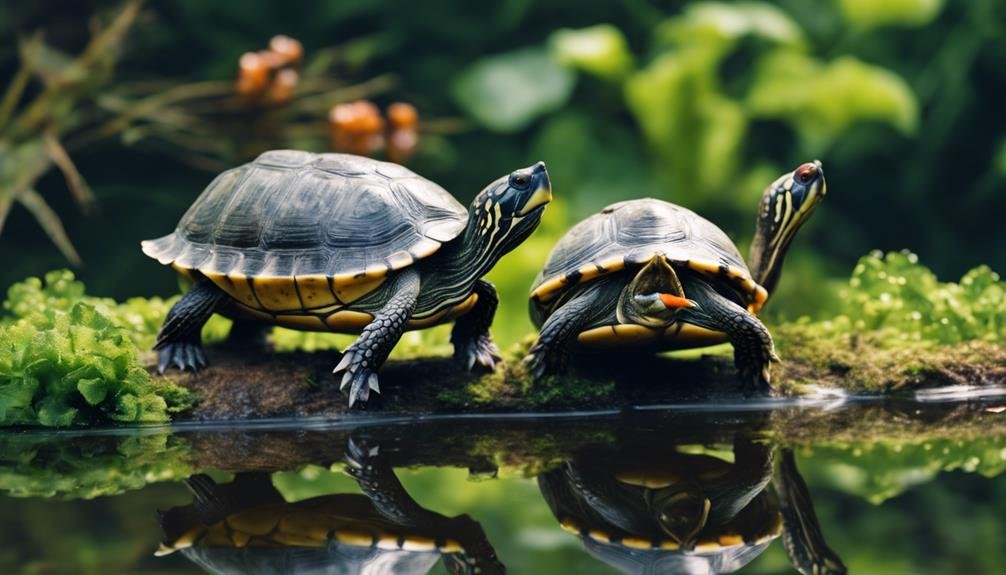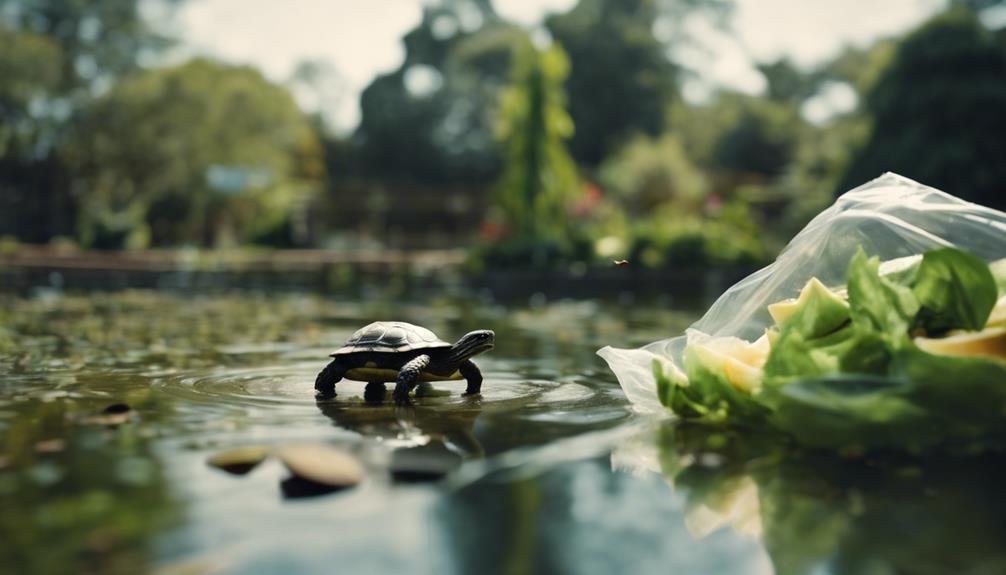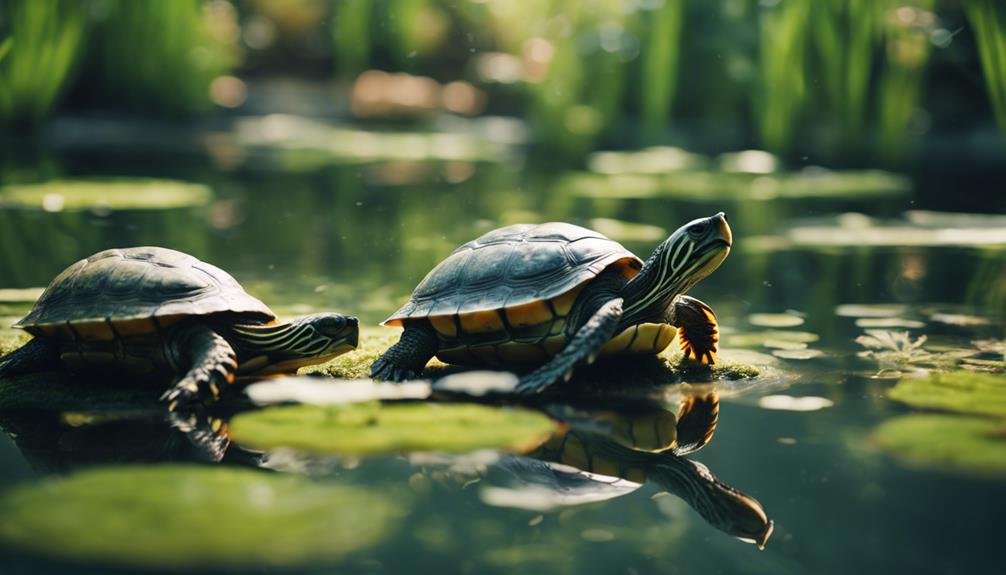As you explore the dietary habits of pond turtles, you’ll find they’re not just simple creatures with important needs. Their diet is a complex blend of proteins, including worms and fish, alongside essential vegetables like kale. However, it’s not just about what they eat but also what they must avoid. Certain foods can be toxic, posing serious risks to their health. Understanding the balance between nutrition and potential hazards is key to ensuring the well-being of these fascinating reptiles. Let’s uncover the intricacies of their diet together and the critical role you play in their habitat, whether natural or in captivity.
Key Takeaways
- Pond turtles eat a variety of proteins such as worms, fish, and insects in their natural pond habitats.
- They balance their diet with plant foods, including dark-green leafy vegetables like kale and cabbage.
- High-quality commercial turtle feed can supplement their diet, providing essential nutrients.
- Foods to avoid include avocados, onions, mushrooms, and processed meats due to toxicity and health risks.
- A balanced diet rich in proteins, vitamins, minerals, and fiber is essential for their health and longevity.
Pond Turtle Natural Habitats
Pond turtles, thriving in warm water temperatures, naturally inhabit wetlands, ponds, and river drainages. These aquatic environments provide the perfect backdrop for their daily activities, from basking in the sun to diving deep for a meal. You’ll find these habitats teeming with life, offering pond turtles a variety of diet options from insects to plants. The water temperature plays an important role in their lifestyle, dictating their active periods and hibernation times.
The habitat of pond turtles isn’t just a home; it’s a complex ecosystem that supports their health and wellbeing. The presence of aquatic vegetation is essential, serving not only as a food source but also as shelter from predators and nesting sites. These turtles are adept swimmers, thanks to their streamlined bodies, allowing them to navigate their watery world with ease. Whether they’re foraging for insects among the plants or basking on a sunlit log, each aspect of their habitat contributes to their survival.
Understanding the habitat and diet of pond turtles highlights the importance of preserving these environments. It’s not just about the water temperature or the availability of insects and plants; it’s about maintaining a balanced ecosystem where these fascinating creatures can thrive.
Essential Foods for Pond Turtles
To ensure their health, you’ll need to balance the diet of your pond turtles with both animal and plant foods. These creatures thrive on a variety of proteins, greens, and vegetables, ensuring they get all the necessary nutrients for peak health. Incorporating high-quality commercial turtle feed into their diet can also play a significant role in meeting their dietary needs effectively. However, it’s important to steer clear of harmful foods like avocados, iceberg lettuce, and processed meats, which can negatively impact their well-being.
When feeding your pond turtles, adjusting the feeding frequency is important. This adjustment should be based on several factors, including the size, age, and activity level of your turtles. Younger, more active turtles may require more frequent feedings compared to older, less active ones. By closely monitoring their growth and health, you can fine-tune their diet and feeding schedule, ensuring they remain healthy and vibrant.
Protein and Vegetable Sources


When considering what to feed pond turtles, it’s important you focus on both animal proteins and vegetables. Common pond protein sources include worms, fish, and insects, while essential vegetables are often dark-green leafy ones like kale and cabbage.
You’ll also want to avoid toxic foods, ensuring your turtle’s diet is both varied and safe.
Common Pond Protein Sources
Understanding the variety of protein sources available for pond turtles, including both animal and vegetable options, is essential for their health and well-being.
Pond turtles thrive on a diet that includes protein from aquatic animals such as worms, fish, crustaceans, and insects. These animal sources are rich in the protein necessary for their growth and maintenance.
However, it’s important to balance these with vegetable protein to prevent health issues like gout, which can arise from overconsumption of protein. The quality and digestibility of the protein source also play a significant role in their diet.
Essential Vegetables for Turtles
Incorporating dark-green leafy vegetables like kale and cabbage into your pond turtles’ diet is essential for their health, providing essential vitamins and minerals.
When feeding your turtle, keep in mind the variety of food sources available in their natural habitat. Here’s a list of key vegetables and fruits to include:
- Squash, Carrots, and Sweet Potatoes: These yellow and orange vegetables are packed with important nutrients.
- Apples and Strawberries: Offer these fruits in moderation to supply essential vitamins.
- Melon: A hydrating source of water and nutrients during feeding times.
- Kale and Cabbage: Dark-green vegetables that are foundational for a turtle’s diet.
Avoiding Toxic Foods
To safeguard your pond turtles’ health, it’s crucial to recognize and avoid feeding them toxic foods, including specific protein and vegetable sources. When feeding pet turtles, you must steer clear of avocados, rhubarb, and all dairy products. These can cause serious health issues.
Also, avoid animal-based food sources like onions, garlic, and mushrooms; they’re harmful to turtles. Processed foods, sugary snacks, or any human leftovers can be toxic and should never make it into your pond.
Additionally, certain plants—daffodils, azaleas, tulips, oleander, foxglove, and lilies—are toxic vegetation and must be kept away from your turtle’s diet. By avoiding these harmful foods, you’ll make certain your pet turtles remain healthy and happy in their pond environment.
Balancing Turtle Nutrition


To keep your pond turtles healthy, you’ll need to understand the essential nutrients they require and how to avoid common dietary deficiencies.
We’ll also guide you through a safe foods list, ensuring you’re providing a balanced diet.
This knowledge is vital for their growth, development, and overall well-being.
Essential Nutrients Overview
Guaranteeing your turtle receives a balanced diet rich in proteins, vitamins, minerals, and fiber is essential for its overall health. As omnivores, your pet turtle needs a diet that meets its complex dietary requirements. This includes a mix of animal-based proteins and plant-based foods to make sure they’re getting essential nutrients. When feeding turtles, it’s important to avoid foods with high levels of chemicals and to include plenty of plant material.
To keep your turtle healthy, focus on:
- Providing a variety of animal-based proteins for growth and repair.
- Including calcium-rich foods for shell and bone health.
- Adding leafy greens and vegetables for necessary fiber.
- Ensuring a diverse diet to cover all dietary needs and prevent nutritional deficiencies.
Common Dietary Deficiencies
Exploring the intricate world of turtle nutrition, it’s important to recognize common dietary deficiencies that can undermine your pet’s health. These deficiencies, often stemming from nutrition imbalances, can greatly impact their well-being.
Insufficient calcium and vitamin D3 are notorious for leading to metabolic bone disease, a common and severe condition in turtles. Furthermore, a lack of essential vitamins and minerals, such as vitamins A, B, and E, can adversely affect your turtle’s health. Protein deficiency is another concern, hindering growth and development.
To combat these issues, proper supplementation alongside a varied diet is essential. Ensuring your turtle receives a balanced intake of these nutrients will help prevent dietary deficiencies and promote a healthier life.
Safe Foods List
When balancing your pond turtle’s nutrition, it’s crucial to include safe foods such as dark leafy greens, yellow and orange vegetables, and a variety of fruits and fungi. Aquatic turtles, being omnivores, thrive on a varied diet that covers all their nutritional needs. To guarantee your turtle is receiving a balanced intake, here are some safe foods to take into account:
- Dark Leafy Greens like kale and spinach, which are rich in essential vitamins and minerals.
- Yellow and Orange Vegetables such as carrots and squash, providing important nutrients.
- Fruits including apples, strawberries, and melons, for additional vitamins and minerals.
- Fungi, with a moderated intake to avoid overconsumption, complement the turtle’s diet with variety.
Incorporating these vegetables, fruits, and fungi ensures your pond turtle obtains a well-rounded nutritional intake.
Toxins and Foods to Avoid


In order to protect your pond turtles’ health, it’s essential to avoid feeding them toxic foods such as avocados, onions, and mushrooms. These items contain harmful substances that can negatively impact turtles, who are naturally omnivores. Their diet often includes a mix of aquatic vegetation and small animals, but introducing these toxic foods can lead to serious health issues.
Moreover, processed meats, sugary foods, and high-fat items should also be excluded from their diet. These aren’t natural to their eating habits and can cause obesity and other health complications. Turtles thrive on a more vegetarian diet, but care must be taken even with plant-based foods. Chemicals called oxalates, found in certain plants, can be toxic to turtles. Additionally, aquatic plants in your pond might be contaminated with pesticides, posing another risk to your turtles’ health.
Feeder fish and other live foods offered to pond turtles should be sourced from clean, uncontaminated water to prevent the accumulation of toxins in turtles’ bodies. Ensuring the aquatic environment and food sources are free from pollutants is key to maintaining the well-being of your pond-dwelling friends.
Feeding Practices in Captivity
To guarantee your captive pond turtles thrive, it’s crucial to feed them a balanced diet that includes proteins, greens, and vegetables. Being omnivores, their diet in captivity should closely mimic what they’d find in their natural habitat, encompassing a variety of food sources to keep them healthy and active. Here’s how you can make sure your turtles are getting everything they need:
- Incorporate High-Quality Pellets: Use commercial turtle feed as the base of their diet to cover any nutritional gaps.
- Add Fresh Produce: Regularly include a mix of leafy greens and vegetables. However, steer clear of avocados and iceberg lettuce, which are harmful or offer little nutritional value.
- Offer Proteins: Supplement their diet with occasional live food, such as insects or small fish, to provide necessary proteins and mimic their natural feeding practices.
- Control Feeding Frequency: Adjust how often you feed your turtles based on their age, size, and activity level, avoiding overfeeding to prevent health issues.
Are Green Sea Turtles’ Diets Different from Pond Turtles’?
Yes, the green sea turtle diet differs significantly from that of pond turtles. While pond turtles primarily eat aquatic plants, insects, and small fish, green sea turtles are herbivores and consume mostly seaweed, algae, and seagrass. Their diets reflect their distinct habitats and lifestyles.
Frequently Asked Questions
What Foods Are Toxic to Turtles?
You need to know that certain foods are toxic to turtles and should be avoided. Vegetables like chives, parsley, and spinach are no-gos because of harmful chemicals.
Don’t even think about giving them human foods like fries or pizza, which can be harmful. Raw meat, fish, or chicken are off the table too, due to the risk of parasites.
Always check with a vet to make sure what you’re feeding is safe.
Do Turtles Have Toxins?
Yes, some turtles do have toxins, particularly the common snapping turtle, which can harbor harmful substances in its muscle tissue. These toxins can make you sick if you eat them, so you’ve got to be cautious.
The toxin levels depend on the turtle’s diet and environment. It’s their way of keeping predators at bay.
Always handle and prepare turtles with care to avoid exposure to these toxins.
What Do Turtles in a Pond Eat?
In a pond, you’ll find turtles munching on a mix of aquatic plants, small fish, insects, and sometimes fruits. They’re not picky and will often eat leafy greens, vegetables, worms, crustaceans, and any fish that are sick or have already died, helping to keep the fish population in check.
This diet plays an essential role in keeping the aquatic ecosystem balanced and the pond environment healthy. So, it’s important to provide them with a diverse diet.
What Do Turtles Eat Algae?
Yes, turtles do eat algae, especially when they’re living in a pond. You’ll find that algae can be a great source of nutrients and minerals for them.
Specifically, species like the red-eared sliders often munch on it. Their appetite for algae not only feeds them but also helps keep algae growth under control in their habitat.
Conclusion
You’ve learned that a balanced diet is key for your pond turtle’s health, incorporating proteins and veggies like kale and cabbage.
Remember, avoiding toxic foods such as avocados, onions, and mushrooms is vital.
By offering a variety of nutritious foods and steering clear of harmful ones, you’ll guarantee your turtle thrives, whether in the wild or captivity.
Stick to these guidelines, and you’re setting the stage for a happy, healthy turtle life.


